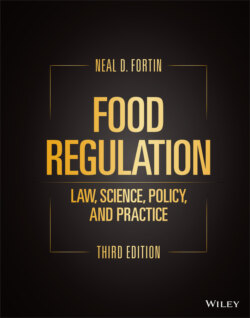Читать книгу Food Regulation - Neal D. Fortin - Страница 16
1.2 A SHORT HISTORY OF FOOD REGULATION IN THE UNITED STATES 1.2.1 Why Do We Have Food Laws?
ОглавлениеFrom the beginnings of civilization, people have been concerned about food quality and safety. The focus of governmental protection originated to protect against economic fraud and to prevent against the sale of unsafe food. As early as the fourth century BCE, Theophrastus (372–287 BCE) in his ten‐volume treatise, Enquiry into Plants, reported on the use of food adulterants for economic reasons. Pliny the Elder’s (CE 23–79) Natural History provides evidence of widespread adulteration, such as bread with chalk, pepper with juniper berries, and even adulteration with cattle fodder.1 Ancient Roman law reflected this concern for adulteration of food with punishment that could result in condemnation to the mines or temporary exile.2
Starting in the thirteenth century, the trade guilds advanced higher food standards. The trade guilds, which included bakers, butchers, cooks, and fruiters among the many tradecrafts, held the power to search for and seize unwholesome products.
Indeed, as the guilds policed the marketplace, they were most interested to ensure continued and strong markets for their goods. Nonetheless, the guilds provide an early demonstration how stringent product quality and safety standards can bring a competitive economic advantage to industries and nations. Trust in food’s safety and wholesomeness is necessary for the market to prosper. A number of commentators have noted the commonality of interest between business self‐interest and stringent product safety standards.3
Regulation of food in the United States dates to the colonial era, but the early food laws were nearly all state and local regulation. Federal activity was limited to imported foods. The first federal food protection law was enacted by Congress in 1883 to prevent the importation of adulterated tea. This was followed in 1896 by the oleo‐margarine statute, which was passed because dairy farmers and the dairy industry objected to the sale of adulterated butter and fats colored to look like butter.
* * * * *
An Early Massachusetts Food Law 4
Passed March 8, 1785
An Act against selling unwholesome Provisions
Whereas some evilly disposed persons, from motives of avarice and filthy lucre, have been induced to sell diseased, corrupted, contagious, or unwholesome provisions, to the great nuisance of public health and peace:
Be it therefore enacted by the Senate and House of Representatives, in General Court assembled, and by the authority of the same, That if any person shall sell any such diseased, corrupted, contagious or unwholesome provisions, whether for meat or drink, knowing the same without making it known to the buyer, and being thereof convicted before the Justices of the General Sessions of the Peace, in the county where such offence shall be committed, or the Justices of the Supreme Judicial Court, he shall be punished by fine, imprisonment, standing in the pillory, and binding to the good behaviour, or one or more of these punishments, to be inflicted according to the degree and aggravation of the offence.
* * * * *
Although adulteration and mislabeling of food had been a centuries‐old concern, the magnitude of the problems increased in the last half of the nineteenth century. This was an era of rapid development in chemistry, bringing advancements in food science, new food additives and colorings, and new means of adulteration. Fortunately, these scientific advances also provided the tools for detecting adulteration.
We face a new situation in history. Ingenuity, striking hands with cunning trickery, compounds a substance to counterfeit an article of food. It is made to look like something it is not; to taste and smell like something it is not; to sell like something it is not, and so deceive the purchaser.
Congressional Record, 49 Congress I Session 1886.
In this era, food production began shifting from the home to the factory, from consumers buying basic ingredients from neighbors in their community, to food processors and manufacturers more often at a distance. With this trend, consumers found it harder to determine the safety and quality of their food. Inevitably, the responsibility for ensuring the safety of foods only shifted from local to state government, and the demand for federal oversight increased. As national markets grew, legitimate manufacturers became concerned that their markets were being harmed by the dishonest and unsafe goods.
